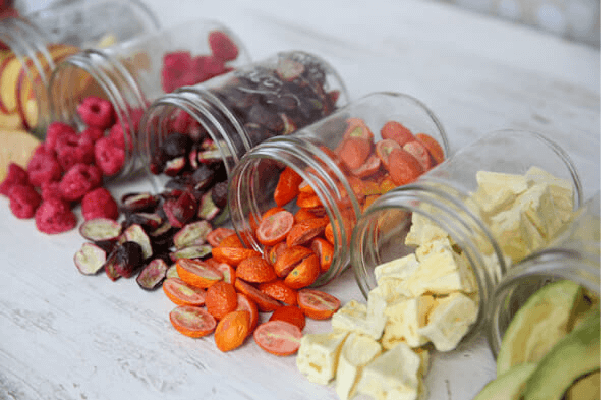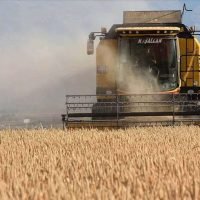Drying process: It is applied in the form of reducing the 80-95 percent water in fruits and vegetables to 10-20 percent to ensure that they last for a long time. This process reduces the water content of vegetables and fruits: their sugar rate rises, and their stamina increases. In addition to the dehydration method, freeze-drying is also frequently used.
Among the methods of storing food, drying can be done in many ways. Therefore, we investigated the differences between the freeze-drying method and the dehydration method. Thus, you can consider freeze-drying to store your food in the healthiest way possible.
Drying Methods in Foods
The way to consume food healthily in all seasons is to provide suitable storage conditions. Therefore, the method of drying vegetables and fruits is of great benefit for storing food. With the developing technology in recent years, the methods of drying and storing food have also improved. Known food drying methods can be described as follows:
Natural Drying:
Natural drying is known as sun drying. It is applied to reduce the product’s water structure by utilizing the sun’s heat. Although it is a traditional method, sun drying has some disadvantages:
- Since the product is dried in an open environment, it remains unprotected against dust, insects, birds, and rodents.
- Large areas are needed for drying.
- For temperature-sensitive and high-quality products, this method is not suitable.
- Since the drying time is long, it is not advantageous in terms of time.
- Sun drying methods may only be suitable for some products.
- Places with unsuitable climatic conditions are also not suitable for natural drying.
Artificial Drying:
It is the method in which the drying process is carried out in closed areas and under controllable conditions. It is advantageous where natural drying is not suitable. This method is also referred to as dehydration in drying methods. What is the dehydration method? Let’s get to know.
What is the Dehydration Method?
Although drying and dehydration are used in the same sense, there is a technical difference between them. Therefore, one of the questions that those who research drying methods for foods are wondering is, “What is dehydration in foods?” there is a question. It is a method that is frequently applied to fruits and vegetables.
The process of evaporating the moisture contained in foodstuffs under controlled conditions is called dehydration. In this way, it is ensured that the food is healthier and longer lasting. One advantage of drying processes is reduced product volume; It provides advantages in storage and transportation. In addition, developing new product formulations with the drying method may be possible.
Among the food drying methods, freeze-drying is more advantageous than the dehydration method for drying many sensitive products. The differences between the freeze-drying method and the dehydration method should, therefore, be well studied. First, let’s get to know the freeze-drying method.
How to Freeze Drying?
Many foodstuffs deteriorate over time. Especially for some foods where conventional drying is inconvenient, the freeze-drying method provides great advantages. For those wondering what freeze drying is, we can explain it as follows. This method involves reducing the pressure after the product has been frozen and removing the frozen water from the product by sublimation. The freeze-drying method is also called lyophilization.
It was originally developed in the 1940s for the production of large volumes of dry plasma and blood products. Then, antibiotics and biological substances were prepared by freeze-drying on an industrial scale. It will be useful to explain the stages of the freeze-drying process when discussing the differences between the freeze-drying method and the dehydration method. The freeze-drying process takes place in 3 stages.
- Freezing: The product is frozen at a very low temperature.
- Drying: It is the sublimation of the frozen liquid, usually under very low pressure, and the removal of the unfrozen liquid from the material to be dried.
- Storage: This is the stage of storage under controlled conditions. It includes storing the product in an oxygen-free, moisture-free, and airtight environment.
Freeze-drying technology can be used in snack products, breakfast cereals, instant soups or ready meals, and coffees in the food industry. It is also used to produce products with high market value that cannot be made with very ordinary separation and drying methods. Examples include drugs, plasma, vaccines, antibiotics, and growth hormones. Freeze drying is an important method for many fields.
Advantages of Freeze Drying Method
The freeze-drying method is the Turkish equivalent of the method known as freeze-drying. For those who want to store their food using this method, “Is freeze drying healthy?”, curious about the answer to the question. Freeze drying does not carry the risks of traditional drying methods. So, it is a safe drying method. The differences between the freeze-drying method and the dehydration method, together with the benefits of freeze-drying, can be listed as follows:
- The nutritional value of freeze-dried foods is preserved. In the dehydration method and canned food, the value of the food decreases.
- Freeze-dried foods become longer-lasting and more useful.
- In freeze-drying, there is no loss of taste and odor in foods. One of the important distinguishing points between different food preservation methods is flavor. In terms of the differences between the freeze-drying method and the dehydration method, the taste of the food may deteriorate in the dehydration method.
- The differences between the freeze-drying method and the dehydration method also appear in the color of the product. In dehydration, the color of the product turns brown. The color of the product does not change in freeze drying.
- Freeze-dried foods can also be stored at room temperature.
- It prolongs the shelf life and prevents food waste.
Difference Freeze Drying and Dehydration Method
The main difference that draws attention in terms of the differences between the freeze-drying method and the dehydration method can be explained as follows:
- Dehydration is done by machines that circulate hot air called solar heat or dehydrators. Natural or artificial heat sources can be used.
- Freeze drying takes place at very high pressure and under vacuum pressure. Under low temperatures and high pressure, water is directly transitioned from the solid state of ice to the gas state of water vapor. Water never goes into liquid form. In other words, it uses the sublimation principle to remove water from the food.
- For the differences between the freeze-drying method and the dehydration method, it should be noted that drying can also be done using salt in dehydration. However, the drying process using salt is limited. Generally suitable for meat and poultry or fish.
- The widespread use of household machines makes freeze-drying technology more accessible and low-cost.
These differences can be summarized as follows:
| Features | Freeze-Drying | Dehydration |
|---|---|---|
| Operating Principle | Uses sublimation to remove water from food | Uses hot air circulation to remove water from food |
| Operating Conditions | Very high pressure and under vacuum pressure | Natural or artificial heat sources can be used |
| Temperature and Pressure | Low temperatures and high pressure | High temperatures |
| State Transition of Water | Water transitions directly from ice to vapor (no liquid form) | Water may transition from liquid form to vapor |
| Use of Salt for Drying | Not applicable | Possible, but mainly suitable for meats, poultry, and fish |
| Cost and Accessibility | More accessible and low-cost due to household machines | Depending on the method and equipment used |
Keep Your Foods Healthy and Delicious
When it comes to the differences between the freeze-drying method and the dehydration method, the usage area of freeze-drying is wide and even more beneficial. With freeze-drying technology, you can quickly and comfortably dry your food. Moreover, you can preserve it healthily. In this respect, we share the advantages of Liyolife Freeze Dryer products for you:
- It provides a quick solution for emergency food supplies, health kits, or survival packs.
- It ensures preserving fresh products obtained from vegetable and fruit gardens for a long time without losing their freshness.
- You can carry your dried foods with you in any environment. Dried foods in natural environments such as camping and holidays provide you convenience.
- Freeze dry method is the healthiest food storage method. You can prepare it at home with Liyolife freeze dryer.
- With this method, which can be used for many foods, food can also be prepared for pets.
Liyolife freeze dryer machines are available in different sizes and features. You can also experience Wi-Fi access and remote control comfort in Liyolife freeze dryer machines, which offer innovative products with developing technology. You can view the Liyolife and Freeze Dryer products on our website for your healthy foods in all seasons.
You can reach our previous article from https://liyolife.com/en/ardsi-machinery-equipment-list/






